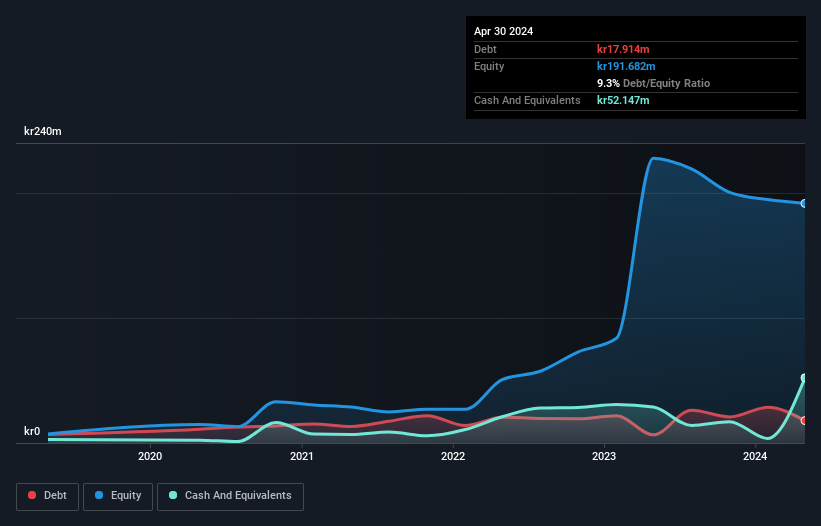- Sweden
- /
- Household Products
- /
- OM:ESGR B
Health Check: How Prudently Does ES Energy Save Holding (STO:ESGR B) Use Debt?

Some say volatility, rather than debt, is the best way to think about risk as an investor, but Warren Buffett famously said that 'Volatility is far from synonymous with risk.' When we think about how risky a company is, we always like to look at its use of debt, since debt overload can lead to ruin. We can see that ES Energy Save Holding AB (publ) (STO:ESGR B) does use debt in its business. But is this debt a concern to shareholders?
What Risk Does Debt Bring?
Debt is a tool to help businesses grow, but if a business is incapable of paying off its lenders, then it exists at their mercy. If things get really bad, the lenders can take control of the business. However, a more usual (but still expensive) situation is where a company must dilute shareholders at a cheap share price simply to get debt under control. Of course, debt can be an important tool in businesses, particularly capital heavy businesses. When we think about a company's use of debt, we first look at cash and debt together.
Check out our latest analysis for ES Energy Save Holding
How Much Debt Does ES Energy Save Holding Carry?
As you can see below, at the end of April 2024, ES Energy Save Holding had kr17.9m of debt, up from kr6.51m a year ago. Click the image for more detail. However, it does have kr52.1m in cash offsetting this, leading to net cash of kr34.2m.

How Healthy Is ES Energy Save Holding's Balance Sheet?
The latest balance sheet data shows that ES Energy Save Holding had liabilities of kr90.4m due within a year, and liabilities of kr6.08m falling due after that. On the other hand, it had cash of kr52.1m and kr58.4m worth of receivables due within a year. So it can boast kr14.1m more liquid assets than total liabilities.
This surplus suggests that ES Energy Save Holding has a conservative balance sheet, and could probably eliminate its debt without much difficulty. Simply put, the fact that ES Energy Save Holding has more cash than debt is arguably a good indication that it can manage its debt safely. There's no doubt that we learn most about debt from the balance sheet. But ultimately the future profitability of the business will decide if ES Energy Save Holding can strengthen its balance sheet over time. So if you're focused on the future you can check out this free report showing analyst profit forecasts.
In the last year ES Energy Save Holding had a loss before interest and tax, and actually shrunk its revenue by 40%, to kr182m. That makes us nervous, to say the least.
So How Risky Is ES Energy Save Holding?
Statistically speaking companies that lose money are riskier than those that make money. And in the last year ES Energy Save Holding had an earnings before interest and tax (EBIT) loss, truth be told. Indeed, in that time it burnt through kr70m of cash and made a loss of kr25m. With only kr34.2m on the balance sheet, it would appear that its going to need to raise capital again soon. Even though its balance sheet seems sufficiently liquid, debt always makes us a little nervous if a company doesn't produce free cash flow regularly. The balance sheet is clearly the area to focus on when you are analysing debt. But ultimately, every company can contain risks that exist outside of the balance sheet. These risks can be hard to spot. Every company has them, and we've spotted 1 warning sign for ES Energy Save Holding you should know about.
At the end of the day, it's often better to focus on companies that are free from net debt. You can access our special list of such companies (all with a track record of profit growth). It's free.
If you're looking to trade ES Energy Save Holding, open an account with the lowest-cost platform trusted by professionals, Interactive Brokers.
With clients in over 200 countries and territories, and access to 160 markets, IBKR lets you trade stocks, options, futures, forex, bonds and funds from a single integrated account.
Enjoy no hidden fees, no account minimums, and FX conversion rates as low as 0.03%, far better than what most brokers offer.
Sponsored ContentValuation is complex, but we're here to simplify it.
Discover if ES Energy Save Holding might be undervalued or overvalued with our detailed analysis, featuring fair value estimates, potential risks, dividends, insider trades, and its financial condition.
Access Free AnalysisHave feedback on this article? Concerned about the content? Get in touch with us directly. Alternatively, email editorial-team (at) simplywallst.com.
This article by Simply Wall St is general in nature. We provide commentary based on historical data and analyst forecasts only using an unbiased methodology and our articles are not intended to be financial advice. It does not constitute a recommendation to buy or sell any stock, and does not take account of your objectives, or your financial situation. We aim to bring you long-term focused analysis driven by fundamental data. Note that our analysis may not factor in the latest price-sensitive company announcements or qualitative material. Simply Wall St has no position in any stocks mentioned.
About OM:ESGR B
Flawless balance sheet with high growth potential.
Market Insights
Community Narratives




